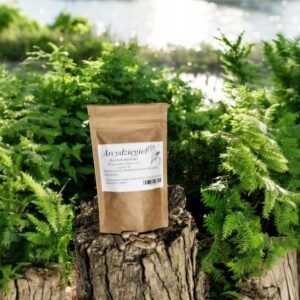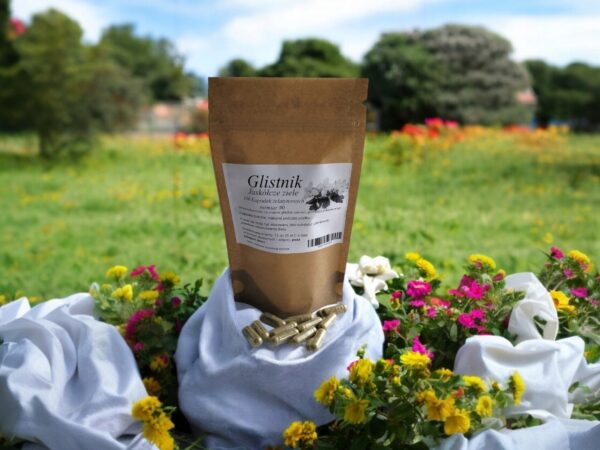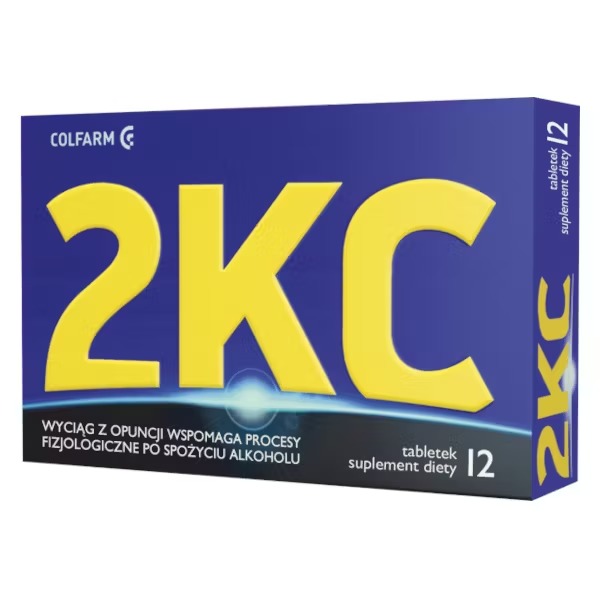Contents : 100 gelatin capsules
- Directions for use: 2 capsules daily. Swallow the capsule and drink plenty of water during a meal, do not exceed the dose.
- Storage conditions: Store in a dry, dark place out of reach of children.
- NOTES: Do not exceed the recommended daily dose. Not for use by pregnant or lactating women or children under 12 years of age.
- The product cannot be used as a substitute for a properly varied diet.
Greater celandine – an effective weapon not only for warts. What is it and what are its properties?
Etymology and synonyms (origin of the name and equivalents)
The Latin genus name Chelidonium comes from the Greek word chelidon (swallow) and refers to the coincidence of the flowering and dying of the plant with the spring arrival and departure of swallows. The species name majus (=major) means greater. In the 17th century, the English physician and botanist Nicholas Culpeper suggested that the name is related to the fact that the celandine herb was used by swallows to regenerate the eyes, in the event of gouging them out of young chicks.
The plant has many folk and common names in Polish. Due to the yellow color of its flowers and milky juice, it is called goldfinch, yellow-headed oxeye, yellow-leafed oxeye, yellow-leafed oxeye, yellow-leafed oxeye, gold-growth, or gold-flower. Due to the use of the plant to combat (“drive out”) worms, especially in children, it is sometimes called celandine, celandine, common celandine, greater celandine, gliśnik, and glizdownik. The reference to the time of swallows’ arrival determines the names jaskółecznik, greater swallow’s herb, jaskółcze nest, greater swallow’s nest, and jaskółnik. Due to the plant’s flowering time, which falls in April, i.e. during Easter, it is often called allelujah.
Other names used include: cendalia, cendalia, cyndalia, cyndalia, cyndabija, cyndelija, cyngalia, cencelia, cencelija, cencylia, cencylija, cyncylija, celidonia, centuria, cecelija, cecelia, milkweed, sapun, sapon, hładysznik, night blindness, skyfall, iodine, dog’s milkweed, rostopada, samozeleń, sobacza lily, wart, wartweed, wart herb, lantonica, God’s leaves, Mary’s herb, golden root, bloody herb, golden pea, and heaven’s gift.
Occurrence (where it comes from)
Greater celandine is a plant widespread in the temperate climate zone in Eurasia and on other continents, where it was introduced. It occurs in almost all of Europe, except for the Scandinavian Peninsula and Iceland. In Asia, it does not occur only in its northern and southern ends. It also grows on the Canary Islands, in northern Africa, North America and in New Zealand. In Poland, it is a common species throughout the foothills, rarer in the lower montane zone. In the Tatras, the sites reach 950 m above sea level, in the Karkonosze 850 m above sea level and in the Bieszczady 600 m above sea level.
Celandine grows in shaded places, on fresh, fertile and very fertile, humus soils, with a neutral to alkaline pH, rich in nitrogen. It occurs on the edges of forests and in thickets, in forest edges and clearings in wet oak-hornbeam and fertile beech habitats. Often in ruderal places, on garbage dumps, roadsides, fences and rubble. A common weed in parks, orchards and gardens. It often grows as an accidental epiphyte on pollarded e.g. willows, where its seeds are carried by ants.
Characteristics (typical features)
Greater celandine is a strongly branched perennial, growing to a height of 1.0 m. It has a tap root system in the form of a thick, conical rhizome with numerous thin lateral roots. The color of the roots is dark brown, almost black, yellow-red inside. In early spring it produces a rosette of large leaves, and then delicate stems. The stem is erect, rounded, forked at the top, the whole rarely protruding hairy. Inside it is empty and usually sunken.
Leaves compound, arranged spirally, dark green and underneath bluish green and sparsely hairy. They are irregularly pinnate with ovate, obtuse and notched-incised segments. Lower leaves petiolate and upper sessile. Flowers bright yellow, four-petaled, 1-2 cm in diameter and gathered in loose pseudoumbels. Two sepals visible only in the bud, quickly falling off. Petals of the corolla not adjacent to each other. Stamens numerous. Pistil with bifid stigma. Blooms from May to September.
The plant quickly flowers, developing capsules, or fruits resembling pods in appearance. The capsule is even, single-chambered, splitting from the base to the top along two flaps. It contains numerous, spherical, shiny, and black seeds. The seeds are eaten by ants, which contribute to their dispersal.
The whole plant has an unpleasant smell and a stinging, bitter taste. When picked, from all injured parts of the plant (stem, leaves), a yellow-orange milky juice leaks, contained in the vacuoles of living cells of the milk tubes. Poisonous plant!
Raw material (what we collect)
The herbal raw material is celandine herb (Herba Chelidonii / Chelidonii herba) and celandine root (Radix Chelidonii / Chelidonii radix) obtained from natural sites and field crops. The roots are dug out in autumn or early spring in the second year of cultivation, or obtained from older plants in natural sites. After extraction and cleaning of above-ground and rotten parts, the roots are rinsed to remove soil. After drying, they can be cut lengthwise to dry faster. The roots can be dried in a drying room at a temperature of 50-60°C.
Celandine herb (young shoots) can be collected 2 or 3 times in the first year of cultivation. The shoots are cut in the initial flowering period of the plants, i.e. in May and June. The collected herb should be handled with caution, because it darkens easily when broken and crushed. The herb can only be dried in natural conditions on warm and rainless days. In a mechanical dryer, it should be dried at an elevated temperature of about 30°C.
Main compounds (what it contains)
The main group of active compounds of celandine are isoquinoline alkaloids. It contains almost 20 of them, mainly in the milky juice. These are mainly chelidonine, chelerythrine, chelitridine, sanguinarine, protopine, alpha-allocryptopine, beta-allocryptopine, berberine, coptisine, stylopine, and sparteine. Their content in the herb is 0.48-1.04%, while in the roots it is up to 1.95% (up to 3.00%). In the root, the main alkaloid is chelidonine, while in the herb it is coptisine.
Additionally, celandine contains organic acids (chelidonic, citric, malic, caffeic, ferulic, coumaric and gentisic), saponins, phenolic acid derivatives, calcium salts, enzymes, flavonoids, biogenic amines (histamine, tyramine), carotenes, vitamin C, glycogen and trace amounts of tannins and essential oil.
Properties and use in home treatment (for what)
Greater celandine has a relaxing effect on the smooth muscles of the bronchi , digestive tract , biliary and urinary tracts and reproductive organs . In connection with the above, the herb can be recommended for abdominal pain caused by intestinal, hepatic and renal colic . It is also used for painful spasms of the reproductive organs . Celandine extracts can be helpful in the treatment of gallstones and during inflammation of the gallbladder. .
Herbal preparations have antiallergic , choleretic , antibacterial , antiviral , protozoic , fungicidal , anesthetic , sedative and analgesic effects. They potentially have anticancer and mild narcotic properties. In home treatment, they are also used for asthma and migraine . The plant can be used for disorders of bile secretion and flow and for lack of appetite caused by a deficiency of gastric juice. It also has properties that lower blood pressure. .
Compresses soaked in the juice of the herb are used to remove warts and verrucas . They are also helpful in treating fungal infections of the skin , psoriasis , difficult-to-heal wounds and skin damage . A decoction of celandine can be used to wash wounds , ulcers , erosions , and chalazions on the eyelids. Celandine extracts can also be used in homeopathy to treat tension headaches , nausea and dry cough , as well as to regulate the work and inflammation of the liver and bile ducts .
Currently, celandine is used primarily as an antispasmodic in diseases of the digestive tract and externally in the treatment of eye diseases and skin diseases. The plant can be used in the form of a decoction or infusion and fresh herb.
Attention! Due to its toxic properties, treatment with this plant can only be carried out with the knowledge and under the supervision of a doctor. Celandine preparations can interact with other drugs. Symptoms of poisoning include pain and burning in the mouth, salivation, abdominal pain and diarrhea. Celandine drugs cannot be used at the end of pregnancy, in peptic ulcer disease, glaucoma or cataracts and acute inflammations of the digestive tract.






































Reviews
Clear filtersThere are no reviews yet.